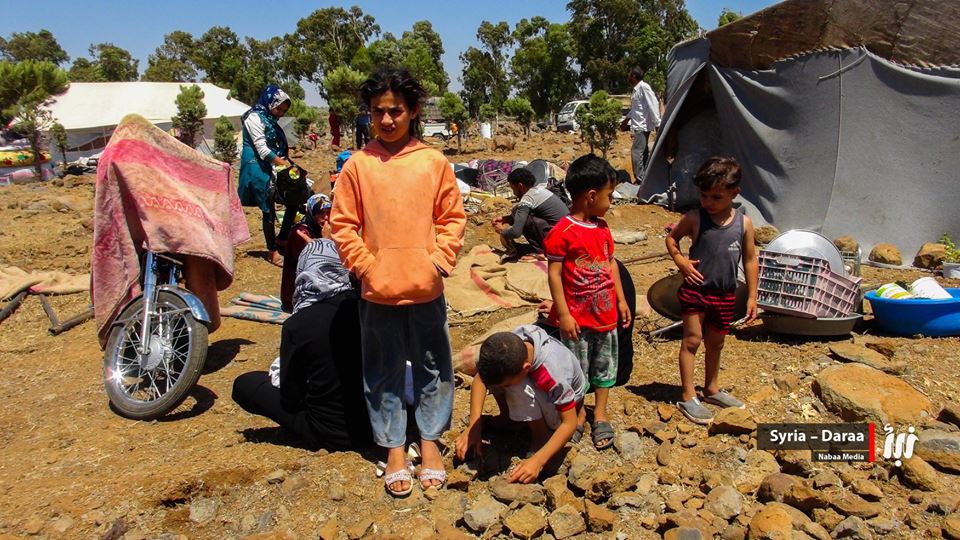Russian-enabled offensive takes key crossing with Jordan
LATEST
Rebels in Daraa Province in southern Syria have agreed a surrender deal with Russian officers, following a 18-day offensive which has displaced 320,000 people — about 40% of the province’s population.
Rebel sources said that fighters would give up their arms.
The talks had broken down twice in the past week over the issue of whether rebels would give up all heavy weapons at the same time or in a staged process, and whether Russian military police or regime security forces would patrol reoccupied areas. On both occasions, Russia and the regime had immediately resumed bombing and ground operations which have killed about 250 people since June 19.
The rebel sources said Russia will guarantee the safe return of the displaced, about 60,000 of whom are in makeshift camps near Jordan and about 160,000 near the Golan Heights. After past recaptures of opposition territory, such as eastern Aleppo city in December 2016 and East Ghouta near Damascus in April, regime forces have abducted, detained, and forcibly conscripted residents.
The pro-Assad offensive, enabled by Russian airstrikes, had captured or forced the capitulation of some towns in both eastern and western Daraa Province, where the Syrian uprising began in March 2011. Most hospitals in the province had shut down and there is little access to water or electricity.
The assault broke a “de-escalation zone” declared by the US and Russia in July 2017, but Washington — after having said four times since late May that it would make a “firm” response to any attacks — took no action.
Just before news of the surrender, pro-Assad forces had taken the Nassib crossing with Jordan following heavy Russian and regime bombardment. Witnesses spoke of a convoy of more than 100 armored vehicles and tanks with Russian and Syrian state flags, bringing hundreds of troops.
OPCW Points to Chlorine Attack on Douma on April 7
The Organization for the Prohibition of Chemical Weapons has pointed to an Assad regime chlorine attack on Douma on April 7, forcing the final capitulation of the East Ghouta region near Damascus.
The OPCW’s Fact Finding Mission reported on Friday that analysis of environmental samples from the site of two helicopter attacks found “various chlorinated organic chemicals”. It said, “Work by the team to establish the significance of these results is on-going.”
At the time of the attacks, which killed about 50 people, medical staff in Douma said symptoms indicated that victims had been exposed to chlorine and to a stronger chemical agent.
The FFM said it had found no organophosphorous nerve agents in the samples. This ruled out sarin, used by the Assad regime in attacks on East and West Ghouta in August 2013 and on northern Hama and Idlib Provinces in March-April 2017.
The mission also interviewed witnesses and collected biological samples and other data. It said a “full chain of custody” was established for the environmental samples which it studied.
The report says the two canisters which purportedly carried the chemical agents are still being examined.
The Assad regime delayed the OPCW for more than a week from getting to the attack sites, while Russian troops disturbed and moved potential evidence, according to activists and residents. Obstruction continued even when inspectors were able to get into Douma. At one of the two sites, they were unable to get access to some apartments because “the representatives of the Syrian Arab Republic stated that they did not have the authority to enter the locked apartment”.
Russian State and Assad regime propaganda insisted that no chemical attack had taken place. The FFM dismissed one line of disinformation put out by Russia, the regime, and pro-Assad activists, saying there was no evidence of a rebel “chemical lab”:
Based on the equipment and chemicals observed during the two on-site visits to the warehouse and the facility suspected by the authorities of the Syrian Arab Republic of producing chemical weapons, there was no indication of either facility being involved in the production of chemical warfare agents.


It’s remarkable how many towns and villages the SAA have liberated in Daraa without firing a shot
Ahahahahaha